
Yesterday, Benson Leung—Google engineer and intrepid USB-C cable tester—dropped the news on Twitter that a new USB-C cable specification has been released. The new spec allows for considerably heftier charging rates between compliant USB-PD devices.
Relatively minimal changes

Although Leung points out that the new specification has been under development for two years, very little has changed. Comparing the USB-C 2.0 standard to today's 2.1 standard, the optional new Extended Power Range (EPR) specification—which bumps maximum voltage up to 48 V, sufficient to deliver 240 W at 5 A—seems to be by far the largest change.
From a consumer's perspective, the physical standard hasn't changed—USB-C type 2.1 devices will plug into USB-C type 2.0 ports, and vice versa. Under the hood, the standards on the midplate have gotten stricter—a new paragraph has been added mandating that pins A4-A9 and B4-B9 (power, power delivery, and legacy USB 2.0 support) must not short to ground during connector mating.
Probably the largest amount of added material in the new specification regards the math and engineering considerations for predicting, detecting, and mitigating arcing when unplugging USB-PD cables. (Arcing while plugging them in is not a problem, since high voltages aren't initiated until after the cable is connected.) This isn't a new problem—arcing can become a problem at only 12 V—but the scope for potential damage increases with the new higher voltage possible.
In addition, 5A Standard Power Range (SPR) cables are being deprecated entirely, to be replaced by the new EPR cables. All full-featured cables (and cables rated for more than 3 A current) are required to be electronically marked, allowing devices to probe the cable itself for its power delivery capabilities (or lack thereof).
USB-PD EPR, laptops, and you

The biggest change by far in the new spec is support for USB Power Delivery at up to 48 V and 5 A—multiply the two and you get 240 W DC. Prior to the ratification of the new EPR standard, USB-PD was limited to 100 W (20 V at 5 A).
The bump in power delivery will make it possible for manufacturers to standardize USB-C chargers across their entire laptop product range—even big engineering laptops like the ones currently serviced by this Dell 240 W DC barrel jack charger. Unfortunately, this probably won't make the chargers themselves universal—there will likely continue to be enough cost difference between ESR and EPR chargers that high-powered laptops will run in reduced performance mode on smaller chargers, just as they do now.
The change should still lead to a significant decrease in charger hassle, though—because even though we'll still have USB-PD SPR and USB-PD EPR chargers, that should pretty much be the extent of it. Meanwhile, DC barrel jacks come in a truly staggering volume of mechanical specifications, with at least 15 of those in common-enough usage to be included in most "universal" laptop chargers.
Article From & Read More ( New USB-C Type 2.1 standard offers up to 240 W power delivery - Ars Technica )https://ift.tt/3ulee0r
Technology

No comments:
Post a Comment